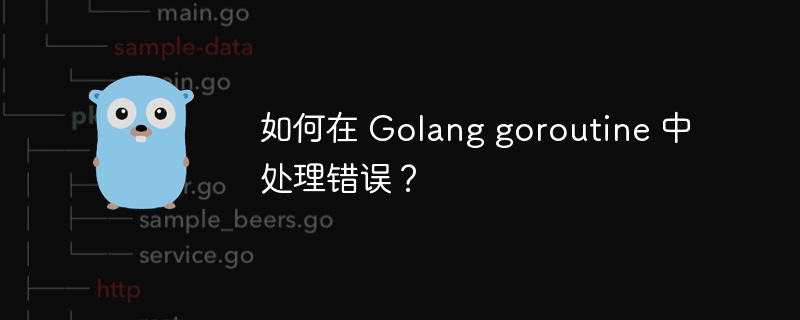如何在 Golang goroutine 中处理错误?
时间:2024-09-18 11:10:07 279浏览 收藏
IT行业相对于一般传统行业,发展更新速度更快,一旦停止了学习,很快就会被行业所淘汰。所以我们需要踏踏实实的不断学习,精进自己的技术,尤其是初学者。今天golang学习网给大家整理了《如何在 Golang goroutine 中处理错误?》,聊聊,我们一起来看看吧!
Go 中的 goroutine 错误处理方法有两种:使用 recover() 函数:需用 defer recover() 包裹处理程序,性能开销较高。使用 context.Context:创建 Context 传递取消和错误,发生错误时调用 CancelFunc 取消 Context。

如何在 Golang goroutine 中处理错误?
goroutine 是 Go 中并发编程的基本构建块。它们允许您在后台并发地执行任务,从而提高应用程序的性能和响应能力。然而,在 goroutine 中处理错误可能有点棘手,因为它们与主 goroutine 不是直接相连的。
异常处理
在 Go 中,我们不使用异常处理来处理错误。相反,我们使用 error 类型来表示错误。error 类型是一个接口,因此任何实现了 error 接口的类型都可以用作错误。
在 goroutine 中处理错误
在 goroutine 中处理错误的传统方法是使用 recover() 函数。recover() 函数从当前 goroutine 恢复任何正在进行的恐慌,并返回导致恐慌的错误。
func worker(errChan chan<- error) {
defer recover()
// 执行可能导致恐慌的任务
// 如果没有发生恐慌,则向通道发送 nil
errChan <- nil
}在主 goroutine 中,您可以使用 select 语句从 errChan 通道读取错误。
func main() {
errChan := make(chan error)
go worker(errChan)
select {
case err := <-errChan:
if err != nil {
// 处理错误
}
}
}改进的方法
使用 recover() 函数处理错误存在一些缺点:
- 不方便: 处理程序必须包裹在
defer recover()块中,这可能很冗长。 - 性能开销:
recover()函数会引发内部恐慌,这会导致一定的性能开销。
一种更好的方法是使用 context.Context 来传播取消和错误。Context 允许您将值从主 goroutine 传递到子 goroutine。您可以使用 WithCancel() 函数创建一个 Context,并在发生错误时调用 CancelFunc 函数以取消所有子 goroutine。
func worker(ctx context.Context) {
for {
select {
case <-ctx.Done():
return
default:
// 执行任务
}
}
}在主 goroutine 中,您可以在发生错误时取消 Context。
func main() {
ctx, cancel := context.WithCancel(context.Background())
go worker(ctx)
// 如果发生错误,则取消 Context
if err != nil {
cancel()
}
}本篇关于《如何在 Golang goroutine 中处理错误?》的介绍就到此结束啦,但是学无止境,想要了解学习更多关于Golang的相关知识,请关注golang学习网公众号!
-
505 收藏
-
503 收藏
-
502 收藏
-
502 收藏
-
502 收藏
-
169 收藏
-
492 收藏
-
474 收藏
-
199 收藏
-
342 收藏
-
434 收藏
-
478 收藏
-
388 收藏
-
424 收藏
-
258 收藏
-
262 收藏
-
484 收藏
-

- 前端进阶之JavaScript设计模式
- 设计模式是开发人员在软件开发过程中面临一般问题时的解决方案,代表了最佳的实践。本课程的主打内容包括JS常见设计模式以及具体应用场景,打造一站式知识长龙服务,适合有JS基础的同学学习。
- 立即学习 543次学习
-

- GO语言核心编程课程
- 本课程采用真实案例,全面具体可落地,从理论到实践,一步一步将GO核心编程技术、编程思想、底层实现融会贯通,使学习者贴近时代脉搏,做IT互联网时代的弄潮儿。
- 立即学习 516次学习
-

- 简单聊聊mysql8与网络通信
- 如有问题加微信:Le-studyg;在课程中,我们将首先介绍MySQL8的新特性,包括性能优化、安全增强、新数据类型等,帮助学生快速熟悉MySQL8的最新功能。接着,我们将深入解析MySQL的网络通信机制,包括协议、连接管理、数据传输等,让
- 立即学习 500次学习
-

- JavaScript正则表达式基础与实战
- 在任何一门编程语言中,正则表达式,都是一项重要的知识,它提供了高效的字符串匹配与捕获机制,可以极大的简化程序设计。
- 立即学习 487次学习
-

- 从零制作响应式网站—Grid布局
- 本系列教程将展示从零制作一个假想的网络科技公司官网,分为导航,轮播,关于我们,成功案例,服务流程,团队介绍,数据部分,公司动态,底部信息等内容区块。网站整体采用CSSGrid布局,支持响应式,有流畅过渡和展现动画。
- 立即学习 485次学习
